Computers in the Re-imagined Series
More actions
Technologies such as computers have been mostly bane and less of a blessing to the Colonials of the Twelve Colonies, despite the obvious conveniences that technology brings. It was computer technology that led to the creation of the Cylons for household to warfare use. These intelligent machines rebelled. To counter their creation's ability to hack into computers, the Colonial defenses, particularly the first battlestars, used computers but did not network them to all but eliminate Cylon infiltration.
Over 40 years after that first Cylon War and with the Cylons apparently long gone, the Colonials slowly returned to technological conveniences. When the Cylons began planning a second war against the Colonials, they chose to infiltrate the Colonial military through yet another program installed throughout fighters and battlestars that was designed to add more convenience: the Command Navigation Program. This program, thanks to Cylon agents disguised as humans who infiltrated Colonial life and sought out people who had access to Colonial computer defense technologies, contained a "backdoor" that allowed the Cylon forces to damage or disable any Colonial vessel with this program. Only non-networked ships (such as most civilian ships or Galactica herself) or those with comparatively primitive computers (such as the Viper Mark II) were all-but-immune to the new Cylon menace.
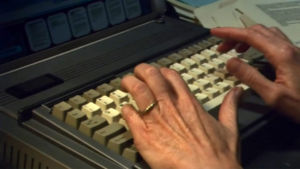
Civilian and Government Computers
- Not much is known of this system other than its existence and the roles they played in the destruction of the Twelve Colonies. This central computer housed key Colonial Fleet logistical information, such as fleet deployment, and was the central system used by Gaius Baltar to create and distribute the Command Navigation Program to all advanced ships and fighters in the Colonial Fleet (Miniseries). It was located within the Ministry of Defense on Caprica (Six Degrees of Separation), since Number Six produced credible-looking footage showing Baltar attaching a bomb to it.
- Lee Adama performed simulations of Cylon attacks in War College to test Colonial defense tactics. One such defense involves the use of EMP devices to fool Cylon forces into believing a nuclear device detonated where no explosion took place. Adama successfully used the electric pulse generators that were offloaded onto Colonial Heavy 798 from Galactica to successfully fool two Cylon Raiders that their nuclear missile attack on Colonial Heavy 798 was successful, while also disabling the warheads of the missiles aimed at the starliner. Adama was amused that this trick actually worked in reality, for in the War College simulations the Cylons were not fooled and destroyed the Colonial targets anyway (Miniseries).
Viper Flight Simulators
- Battlestar Galactica loses many pilots to Cylon attack or accident in the first weeks of exodus from the Colonies. Lieutenant Kara Thrace is ordered to become flight instructor to train nuggets as new pilots. Normally, pilots are trained on simulators, presumably on one of the Colonies or a more advanced battlestar, which used complex computers to immerse a trainee into the feel of Viper combat. Unfortunately, Galactica did not have simulators onboard, so Thrace teaches the new pilots using actual Vipers (Act of Contrition). Months later, the advanced battlestar Pegasus joins the Fleet. The modern resources of this battlestar include flight simulators onboard. Rookie pilots BB and Jo-Jo arrive on Galactica to begin their tour after training with these simulators on Pegasus (Scar).
Personal Computers
- In preparation for converting Galactica into a museum and education center, then-Secretary of Education Laura Roslin pleads unsuccessfully to then-Commander William Adama to allow installation of a network for personal computers to be used for teaching and information by students and visitors (Miniseries).
- Terrorist Sesha Abinell uses a personal laptop computer in her quarters as she compiles and gathers information on Cylon and Colonial comspiracy theories (Sacrifice).
Battlestar Computers
An original battlestar such as Galactica has several computers dedicated to many critical ship functions. Several specific computers have been mentioned in the Miniseries and Re-imagined Series. This list is not inclusive; an original battlestar like Galactica is still a very complex spacecraft. Advanced battlestars such as Pegasus, with its networked computers, may have more or fewer computers or distributed functionality. It is likely that Pegasus is not as strongly networked as before the Fall of the Twelve Colonies to create similar defenses against Cylon intrusion.
Although the battlestar normally does not have a central computer network in place, Galactica does possess a gateway, which, in Galactica's case, is likely managed within the Mainframe itself and not as a larger network topology. The Mainframe's normally-isolated gateway can be linked to the other computers (as Gaeta does in "Scattered").
Navigation ComputerAlso known as the "Nav" computer, it tracks the battlestar's position and handles sublight travel and RCS translations. It is very likely that DRADIS sensor information is obtained and managed by the Navigation Computer then passed on to the Tactical Officer and the Command & Control Center in the CIC. |
 |
FTL ComputerThe FTL computer manages the complex calculations necessary for an FTL Jump. Information for these Jumps on a more advanced battlestar such as Pegasus are probably transmitted from the Navigation Computer by the battlestar's network. On Galactica, however, the FTL computer receives the spatial coordinates manually from the Tactical Officer or its Communications Officer. The FTL Computer also manages the star fixes of the Jump coordinates to compensate for inertial drift that naturally occurs over time. The Tactical Officer generates a series of emergency Jump coordinates for the Fleet with the FTL computer. This information is relayed by the Tactical Officer to other ships regularly. It is likely that the flight pods are also controlled through the FTL computer as they must be retracted prior to a Jump.[1] |
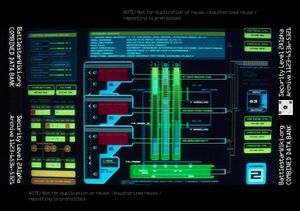 |
Damage Control ComputerThe Damage Control computer relays information to the CIC on malfunctioning or damaged areas of the battlestar, presumably from various sensors throughout the ship. It also has access to radiation sensors in the event of nuclear attack to warn against dangerous radiation levels that could harm the crew.[2] In the event that the DC computer is compromised by a hostile force, as was threatened in "Valley of Darkness", the safeties can be overridden and the crew can be vented into space. |
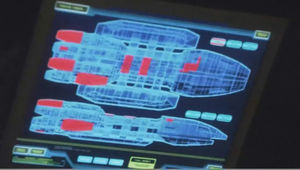 |
Fire Control ComputerThe Fire Control computer manages a battlestar's primary offensive weapons, the central flak turret and smaller port and starboard turrets along the length of each side of the ship. It is presumed that the Fire Control computers report to crewmembers responsible for the upkeep of ammunition on the guns when to reload an particular turret. The Fire Control computer can target individual bogeys with the flak turret guns, which, in tandem with the smaller turrets, make even Galactica, an old original battlestar from the first Cylon War, a formidable foe to encounter.[3] |
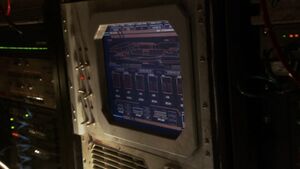 |
Mainframe Computer
This computer likely manages secondary functions of the ship, such as communications. The mainframe likely provides extra calculating power for other ship tasks when required, and may also serve as the ship's library for tactical information.[4] Of all the computers on Galactica, this computer is likely very resistant by design to infiltration since it controls communication traffic (and thus is accessible to Cylon external intrusion by wireless). The mainframe likely possesses a basic gateway, but, per Galactica's no-networks edict, it is typically unused.
Avionics
- The computer systems found on fighters and support aircraft of a capital ship are generally described by the term avionics (AVIation electrONICS). In the world of Battlestar Galactica, aircraft terminology is intermixed with spacecraft terminology--note the use of "CAG" and Commander Adama's use of the word "planes" to Chief Galen Tyrol to describe the Viper space fighter (Litmus). As the term "avionics" was used in the episode "Flesh and Bone" to describe the flight electronics on the captured Raider, despite its aeronautical connotation, it will be used here.
Colonial Avionics
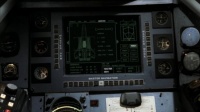
The avionics found on Vipers and Raptors likely include these components, which vary in availability or degrees of complexity depending on the craft's age or purpose.
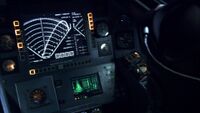
- A non-directional medium-range wireless communications for ship-to-ship and ship-to-planet contact
- DRADIS hardware for enemy targeting, squadron formation flight maneuvers, and the like
- A Colonial transponder for IFF "friend or foe" identification
- Stellar positioning system for proper sublight or FTL positioning
- Instrument Landing Systems (ILS), an automatic ("hands-off") landing system guidance package
| In the case of modern (pre-holocaust) spacecraft, many of these systems were likely tied into (either as a software or firmware component) of the tainted Command Navigation Program. Evidence for this is strong as viewers watched Jackson Spencer's Mark VII Viper lose power, communications, flight control, DRADIS, and apparently ejection control after Cylon fighters "rooted", or counter-commanded his Viper to shut down, thanks to the backdoors installed in these modern avionics packages (Miniseries) |  |
Older Vipers, like the Mark II, used more primitive avionics with far less dependence on computer programming. Designed for the First Cylon War to engage an enemy that commonly used computer infiltration as an attack, older Colonial spacecraft likely did not possess conveniences that modern Vipers and their pilots took for granted, such as auto-landing systems.
Larger craft such as Raptors could manage Jumps and so came equipped with more advanced avionics to handle FTL travel.
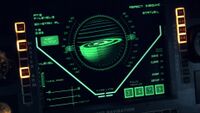
Galactica prohibits computerized landings, so all pilots perform manual approach and landings in non-combat modes. No information has been given in the series if Mark II Vipers are capable of auto-landings in the manner that Mark VII's demonstrate (Miniseries).
It's unknown if Mark VII fighters are still capable or allowed to perform auto-landings on Pegasus with its change of commanders or its forced disuse of the CNP, the software that made auto-landings (in whole or in part) possible.
Cylon Avionics
Little has been revealed of the history or configuration of modern Cylon computers or avionics on their Heavy Raider or basestars, but a few scraps of information have been revealed about the Cylon Raider, the primary fighter-interceptor for the Cylon fleet.
Cylon Raiders contain some level of avionics that co-exist amidst the biological components that form the "pilot" within the fuselage of the fighter. Kara Thrace identified the mechanical linkage within the craft, and Galen Tyrol's team had identified the fire control, navigation, and FTL drive components in addition to an actual avionics package (Flesh and Bone). Galactica flight crews later rigged a flight control console that mated with the avionics for human readability.
The Cylons moved to biomechanical pilots rather than using Centurions or other robotic pilot for three probable reasons:
- The Cylon's monothesistic belief in God and their belief in procreation (machines cannot procreate, but living organisms can) suggest that they believe a biological pilot would be more effective. A Raider pilot is programmed with a basic personality akin to a predatory animal. Unlike the logic of a Centurion, a Raider pilot is capable of improvements in its programming--it can learn and anticipate changes in battle (Six Degrees of Separation, Scar).
- In battle, Colonial forces may attempt electronic countermeasures that could affect the performance or operation of a fully-mechanical Cylon Raider or a craft piloted by autonomous Cylon Centurions. As the Colonials moved to simplier technologies to combat Cylon ECM, so did the Cylons--like a human Viper pilot, the modern Raider with its biologics cannot be easily disabled by ECM.
- A Raider's personality, like a Cylon agent, is downloadable and transferable should the fighter be destroyed. This provides the Cylons a dramatic tactical advantage over the Colonials since the knowledge of a Raider isn't lost on death, allowing it to improve its fighting as well as allowing risker tactics (such as ramming) without permanent loss of self, provided a Resurrection Ship or the Cylon homeworld is sufficiently close to retrieve a signal (Scar).
Cylon spacecraft avionics, however, can be affected by computer infiltration with the right methods. The cooperative Cylon infiltrator copy of Sharon Valerii used herself as a backdoor to send a version of a Cylon virus to shut down power to a massive Cylon fleet en route to attack Galactica (Flight of the Phoenix). It was not shown whether the biologics of the Cylon Raiders are themselves affected by this unexpected infiltration from Valerii.
Computer History
- See main article Colonial Computer History
Sources
- ↑ One of Gaeta's responsibilities is to monitor DRADIS contacts. To navigate, a battlestar must use some way to determine its location relative to other objects, so the Navigation and DRADIS connection must exist.
- ↑ While Colonel Tigh was on a handset ordering the retraction of the pods as the battlestar began its escape from Ragnar Anchorage, many events within the ship must be coordinated (bulkheads closing, motors for the pod movement activated, etc.) While there was likely a person in CIC or elsewhere that flips a switch or types in a computer command, there must still be a computer used to coordinate these events as they are too many to manage in a limited amount of time (Miniseries).
- ↑ Galactica's flak turret guns are seen directly targeting specific missiles during the Battle of Ragnar Anchorage (Miniseries).
- ↑ Sharon Valerii: "Mr. Gaeta, can you set me up with a fiber-optic com link? I need broadcast to all frequencies and direct link to the mainframe." (Flight of the Phoenix)
